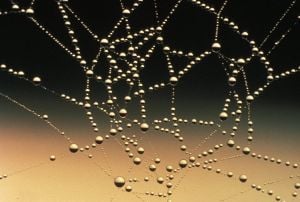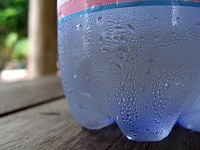Difference between revisions of "Condensation" - New World Encyclopedia
| Line 1: | Line 1: | ||
| − | {{ | + | {{Claimed}} |
| + | {{otheruses}} | ||
| + | [[Image:watervapor_cup.jpg|right|thumb|Water condenses into visible droplets after evaporating from a cup of hot tea.]] | ||
| − | + | '''Condensation''' is the change in matter of a substance to a denser phase, such as a [[gas]] (or vapor) to a [[liquid]].<ref>{{GoldBookRef|title=condensation ''in atmospheric chemistry''|file=C01235}}</ref> Condensation commonly occurs when a vapor is cooled to a liquid, but can also occur if a vapor is compressed (i.e., [[pressure]] on it increased) into a liquid, or undergoes a combination of cooling and compression. Liquid which has been condensed from a vapor is called '''condensate'''. A device or unit used to condense vapors into liquid is called a '''[[condenser]]'''. Condensers are used in [[heat exchanger]]s which have various designs, and come in many sizes ranging from rather small (hand-held) to very large. | |
| + | The water seen on the outside of a cold glass on a hot day is condensation. | ||
| − | + | ==Condensation of water in nature== | |
| + | [[Image:Water drops on spider web.jpg|left|thumb|[[Dew]] on a spider web]] | ||
| + | Water vapor from air which naturally condenses on cold surfaces into liquid water is called [[dew]]. Water vapor will only condense onto another surface when that surface is cooler than the [[temperature]] of the water vapor, or when the water vapor equilibrium in air, i. e. saturation [[humidity]], has been exceeded. When water vapor condenses onto a surface, a net warming occurs on that surface. [[Image:Condensation_on_water_bottle.jpg|200px|thumb|Condensation on a cold [[Bottled Water|bottle of water]].]]The water molecule brings a [[Latent heat|parcel of heat]] with it. In turn, the temperature of the [[atmosphere]] drops very slightly. | ||
| − | [[ | + | In the [[Earth's atmosphere|atmosphere]], condensation of water vapor is what produces [[cloud]]s. The [[dew point]] of an air parcel is the temperature to which it must cool before condensation in the air begins to form. |
| + | |||
| + | Also, a net condensation of water vapor occurs on surfaces when the temperature of the surface is at or below the dew point temperature of the atmosphere. Deposition is a type of condensation. [[Deposition (physics)|Deposition]], the direct formation of ice from water vapor, is a type of condensation. Frost and [[snow]] are examples of deposition. | ||
| + | |||
| + | === Condensation in buildings === | ||
| + | |||
| + | Condensation is the most common form of dampness encountered in buildings. In buildings the internal air can have a high level of relative humidity due to the activity of the occupants (such as cooking, drying clothes, breathing, and so forth). When this air comes into contact with cold surfaces such as windows and cold walls it can condense, causing dampness.<ref>http://www.buildingpreservation.com/Condensation.htm Building Preservation (Condensation - the basics)</ref> | ||
| + | |||
| + | == Applications of condensation == | ||
| + | |||
| + | Condensation is a crucial component of [[distillation]], an important application in laboratory and industrial chemistry application. | ||
| + | |||
| + | Because condensation is a naturally occurring phenomenon, it can often be used to generate water in large quantities for human use. In fact, there are many structures that are made solely for the purpose of collecting water from condensation, such as [[fog fence]]s, [[air well]]s and [[dew pond]]s. Such systems can often be used to retain soil moisture in areas where active [[desertification]] is occurring. In fact, certain organizations use education about water condensers in efforts to effectively aid such areas.<ref>http://www.fogquest.org/</ref> | ||
| + | |||
| + | ==See also== | ||
| + | |||
| + | * [[Distillation]] | ||
| + | * [[Liquid]] | ||
| + | * [[Solid]] | ||
| + | |||
| + | == Notes == | ||
| + | <references/> | ||
| + | |||
| + | ==References== | ||
| + | |||
| + | * {{cite web | url = http://www.ces.purdue.edu/pork/images/jones/condense.jpg | title = Condensation principles (Picture) }} | ||
| + | * {{cite web | url =http://www.versacomit.com/experiment/experiment_evaporation.wmv | title = Condensation & Evaporation Experiment (Video) }} | ||
| + | |||
| + | ==External links== | ||
| + | |||
| + | *[http://www.specifypga.com/index/articles/articles_section_list/1/Condensation%20Myths%20and%20Facts/ Condensation Myths and Facts] | ||
| + | |||
| + | |||
| + | :{| class="wikitable" | ||
| + | |- | ||
| + | <tr bgcolor="#eeeeee" align = "center"><td>'''From'''</td><td colspan=4> '''To''' </td></tr> | ||
| + | |- | ||
| + | !align = "center"| | ||
| + | !align = "center"|[[Solid]] | ||
| + | !align ="center"|[[Liquid]] | ||
| + | !align ="center"|[[Gas]] | ||
| + | !align ="center"|[[Plasma (physics)|Plasma]] | ||
| + | |- | ||
| + | !align ="left"|Solid | ||
| + | |align ="center"|Solid-Solid Transformation | ||
| + | |align ="center"|[[Melting]] | ||
| + | |align ="center"|[[Sublimation (chemistry)|Sublimation]] | ||
| + | |align ="center"|- | ||
| + | |- | ||
| + | !align ="left"|Liquid | ||
| + | |align ="center"|[[Freezing]] | ||
| + | |align ="center"|N/A | ||
| + | |align ="center"|[[Boiling]]/[[Evaporation]] | ||
| + | |align ="center"|- | ||
| + | |- | ||
| + | !align ="left"|Gas | ||
| + | |align ="center"|[[Deposition (physics)|Deposition]] | ||
| + | |align ="center"|[[Condensation]] | ||
| + | |align ="center"|N/A | ||
| + | |align ="center"|[[Ionization]] | ||
| + | |- | ||
| + | !align ="left"|Plasma | ||
| + | |align ="center"|- | ||
| + | |align ="center"|- | ||
| + | |align ="center"|Recombination/Deionization | ||
| + | |align ="center"|N/A | ||
| + | |} | ||
| + | |||
| + | [[Category:Physical sciences]] | ||
| + | [[Category:Physics]] | ||
| + | |||
| + | {{credit|159532346}} | ||
Revision as of 20:49, 23 September 2007
- For other uses, see Condensation (disambiguation).
Condensation is the change in matter of a substance to a denser phase, such as a gas (or vapor) to a liquid.[1] Condensation commonly occurs when a vapor is cooled to a liquid, but can also occur if a vapor is compressed (i.e., pressure on it increased) into a liquid, or undergoes a combination of cooling and compression. Liquid which has been condensed from a vapor is called condensate. A device or unit used to condense vapors into liquid is called a condenser. Condensers are used in heat exchangers which have various designs, and come in many sizes ranging from rather small (hand-held) to very large.
The water seen on the outside of a cold glass on a hot day is condensation.
Condensation of water in nature
Water vapor from air which naturally condenses on cold surfaces into liquid water is called dew. Water vapor will only condense onto another surface when that surface is cooler than the temperature of the water vapor, or when the water vapor equilibrium in air, i. e. saturation humidity, has been exceeded. When water vapor condenses onto a surface, a net warming occurs on that surface.
The water molecule brings a parcel of heat with it. In turn, the temperature of the atmosphere drops very slightly.
In the atmosphere, condensation of water vapor is what produces clouds. The dew point of an air parcel is the temperature to which it must cool before condensation in the air begins to form.
Also, a net condensation of water vapor occurs on surfaces when the temperature of the surface is at or below the dew point temperature of the atmosphere. Deposition is a type of condensation. Deposition, the direct formation of ice from water vapor, is a type of condensation. Frost and snow are examples of deposition.
Condensation in buildings
Condensation is the most common form of dampness encountered in buildings. In buildings the internal air can have a high level of relative humidity due to the activity of the occupants (such as cooking, drying clothes, breathing, and so forth). When this air comes into contact with cold surfaces such as windows and cold walls it can condense, causing dampness.[2]
Applications of condensation
Condensation is a crucial component of distillation, an important application in laboratory and industrial chemistry application.
Because condensation is a naturally occurring phenomenon, it can often be used to generate water in large quantities for human use. In fact, there are many structures that are made solely for the purpose of collecting water from condensation, such as fog fences, air wells and dew ponds. Such systems can often be used to retain soil moisture in areas where active desertification is occurring. In fact, certain organizations use education about water condensers in efforts to effectively aid such areas.[3]
See also
Notes
- ↑ International Union of Pure and Applied Chemistry. "condensation in atmospheric chemistry". Compendium of Chemical Terminology Internet edition.
- ↑ http://www.buildingpreservation.com/Condensation.htm Building Preservation (Condensation - the basics)
- ↑ http://www.fogquest.org/
ReferencesISBN links support NWE through referral fees
External links
From To Solid Liquid Gas Plasma Solid Solid-Solid Transformation Melting Sublimation - Liquid Freezing N/A Boiling/Evaporation - Gas Deposition Condensation N/A Ionization Plasma - - Recombination/Deionization N/A
Credits
New World Encyclopedia writers and editors rewrote and completed the Wikipedia article in accordance with New World Encyclopedia standards. This article abides by terms of the Creative Commons CC-by-sa 3.0 License (CC-by-sa), which may be used and disseminated with proper attribution. Credit is due under the terms of this license that can reference both the New World Encyclopedia contributors and the selfless volunteer contributors of the Wikimedia Foundation. To cite this article click here for a list of acceptable citing formats.The history of earlier contributions by wikipedians is accessible to researchers here:
The history of this article since it was imported to New World Encyclopedia:
Note: Some restrictions may apply to use of individual images which are separately licensed.


